Advertisements
Advertisements
प्रश्न
A villager Itwaari has a plot of land of the shape of a quadrilateral. The Gram Panchayat of the village decided to take over some portion of his plot from one of the corners to construct a Health Centre. Itwaari agrees to the above proposal with the condition that he should be given equal amount of land in lieu of his land adjoining his plot so as to form a triangular plot. Explain how this proposal will be implemented.
उत्तर
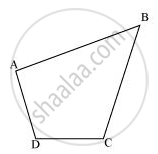
Let quadrilateral ABCD be the original shape of the field.
The proposal may be implemented as follows.
Join diagonal BD and draw a line parallel to BD through point A. Let it meet
the extended side CD of ABCD at point E. Join BE and AD. Let them intersect each other at O. Then, portion ΔAOB can be cut from the original field so that the new shape of the field will be ΔBCE. (See figure)
We have to prove that the area of ΔAOB (portion that was cut so as to construct Health Centre) is equal to the area of ΔDEO (portion added to the field so as to make the area of the new field so formed equal to the area of the original field)
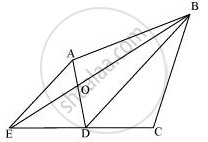
It can be observed that ΔDEB and ΔDAB lie on the same base BD and are between the same parallels BD and AE.
∴ Area (ΔDEB) = Area (ΔDAB)
⇒ Area (ΔDEB) − Area (ΔDOB) = Area (ΔDAB) − Area (ΔDOB)
⇒ Area (ΔDEO) = Area (ΔAOB)
APPEARS IN
संबंधित प्रश्न
In the given figure, E is any point on median AD of a ΔABC. Show that ar (ABE) = ar (ACE)
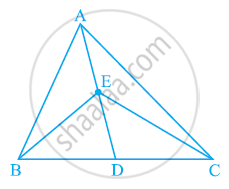
In a triangle ABC, E is the mid-point of median AD. Show that ar (BED) = 1/4ar (ABC).
D and E are points on sides AB and AC respectively of ΔABC such that
ar (DBC) = ar (EBC). Prove that DE || BC.
The side AB of a parallelogram ABCD is produced to any point P. A line through A and parallel to CP meets CB produced at Q and then parallelogram PBQR is completed (see the following figure). Show that
ar (ABCD) = ar (PBQR).
[Hint: Join AC and PQ. Now compare area (ACQ) and area (APQ)]

In the given figure, AP || BQ || CR. Prove that ar (AQC) = ar (PBR).

In the following figure, D and E are two points on BC such that BD = DE = EC. Show that ar (ABD) = ar (ADE) = ar (AEC).
Can you answer the question that you have left in the ’Introduction’ of this chapter, whether the field of Budhia has been actually divided into three parts of equal area?
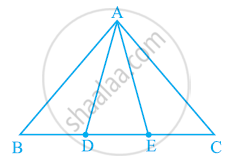
[Remark: Note that by taking BD = DE = EC, the triangle ABC is divided into three triangles ABD, ADE and AEC of equal areas. In the same way, by dividing BC into n equal parts and joining the points of division so obtained to the opposite vertex of BC, you can divide ΔABC into n triangles of equal areas.]
X and Y are points on the side LN of the triangle LMN such that LX = XY = YN. Through X, a line is drawn parallel to LM to meet MN at Z (See figure). Prove that ar (LZY) = ar (MZYX)
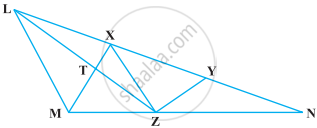
The medians BE and CF of a triangle ABC intersect at G. Prove that the area of ∆GBC = area of the quadrilateral AFGE.
In ∆ABC, if L and M are the points on AB and AC, respectively such that LM || BC. Prove that ar (LOB) = ar (MOC)
If the medians of a ∆ABC intersect at G, show that ar (AGB) = ar (AGC) = ar (BGC) = `1/3` ar (ABC)
